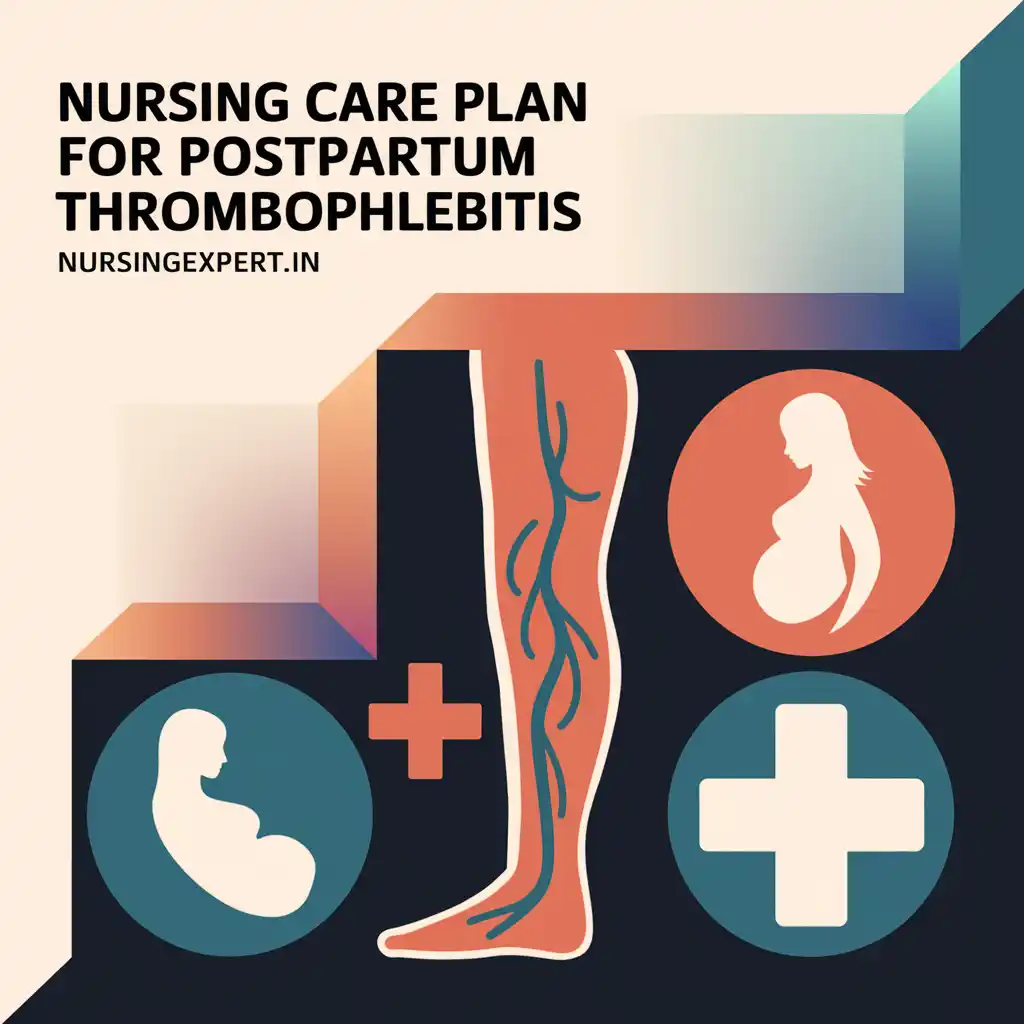Nursing Care Plans for Postpartum Thrombophlebitis: Postpartum thrombophlebitis is a serious condition that can develop after childbirth, characterized by inflammation and clot formation in the veins, often in the lower extremities. Effective nursing care is critical to prevent complications such as deep vein thrombosis (DVT) and pulmonary embolism. This article presents seven essential nursing care plans tailored for postpartum thrombophlebitis. It covers thorough assessment, risk reduction, targeted interventions, patient education, and interdisciplinary collaboration. A downloadable PDF version of these care plans is available for clinical practice and exam preparation.
Thank you for reading this post, don't forget to subscribe!
1. Introduction
Postpartum thrombophlebitis involves inflammation of the veins with clot formation after childbirth. It can lead to pain, swelling, and potentially serious complications such as DVT or pulmonary embolism if not managed effectively. Nurses play a crucial role in early detection, prevention, and management of this condition. This guide provides seven essential nursing care plans that address comprehensive assessment, risk reduction, and patient education to ensure maternal safety and well-being.


2. Understanding Postpartum Thrombophlebitis
Postpartum thrombophlebitis is typically seen in the days following childbirth. The condition is marked by inflammation and clot formation in the veins, usually in the lower extremities. It may present as localized pain, redness, and swelling along the course of the affected vein. Understanding the underlying mechanisms, which include hypercoagulability in the postpartum period, is essential for effective nursing management.
3. Etiology and Risk Factors
Etiology:
- Postpartum Hypercoagulability: Hormonal changes after childbirth increase blood clotting tendencies.
- Venous Stasis: Reduced mobility during the postpartum period contributes to clot formation.
- Vascular Injury: Trauma during delivery may damage the vein walls.
Risk Factors:
- Cesarean Section: Surgical delivery increases the risk of thrombosis.
- Obesity: Excess weight can exacerbate venous stasis.
- Previous Thromboembolic Events: A history of clots heightens risk.
- Prolonged Immobility: Extended bed rest or limited physical activity postpartum.
Identifying these risk factors is vital for tailoring care plans and preventive strategies.
4. Signs and Symptoms
Key signs and symptoms of postpartum thrombophlebitis include:
- Localized Pain: Often in the calf or thigh, worsening with movement.
- Redness and Warmth: Over the affected area.
- Swelling and Edema: Particularly in the lower extremities.
- Tenderness Along the Vein: Palpable cord-like structures may be present.
- Fever: In severe cases, indicating infection or systemic involvement.
Early recognition of these signs ensures prompt intervention.
5. Nursing Diagnoses for Postpartum Thrombophlebitis
Using NANDA guidelines, common nursing diagnoses include:
- Risk for Ineffective Peripheral Tissue Perfusion related to venous stasis and thrombus formation.
- Acute Pain related to inflammation and clot formation as evidenced by localized tenderness and discomfort.
- Risk for Impaired Skin Integrity related to edema and prolonged pressure.
- Deficient Knowledge regarding clot prevention and self-care strategies in the postpartum period.
- Anxiety related to fear of complications such as DVT and pulmonary embolism.
These diagnoses provide a foundation for developing targeted care plans.
6. Nursing Interventions and Management Strategies
A. Immediate Interventions
- Vital Signs Monitoring:
Continuously assess heart rate, blood pressure, and temperature to detect early signs of complications. - Pain Management:
Administer prescribed analgesics and encourage non-pharmacological interventions like warm compresses. - Edema Reduction:
Elevate the affected extremity and apply compression stockings if prescribed.
B. Preventive Measures
- Mobilization:
Encourage early ambulation and guided exercises to promote venous return. - Fluid Management:
Ensure adequate hydration to maintain optimal blood flow. - Anticoagulant Therapy:
Administer prophylactic anticoagulants as ordered to prevent further clot formation.
C. Long-Term Management
- Patient Education:
Teach the patient about lifestyle modifications, including regular exercise, proper hydration, and adherence to medication. - Follow-Up Care:
Schedule regular follow-ups to monitor the patient’s recovery and adjust interventions as necessary. - Monitoring for Complications:
Educate on recognizing signs of deep vein thrombosis (DVT) or pulmonary embolism and when to seek emergency care.
7. Patient and Family Education
Effective education strategies include:
- Condition Explanation:
Clearly explain what postpartum thrombophlebitis is, its causes, and potential complications. - Self-Care Techniques:
Teach proper leg elevation, exercises to promote circulation, and the use of compression stockings. - Medication Adherence:
Emphasize the importance of taking prescribed anticoagulants and analgesics. - Warning Signs:
Instruct on symptoms like increased swelling, severe pain, or shortness of breath that require immediate medical attention. - Lifestyle Modifications:
Discuss strategies for staying active and maintaining a healthy weight. Empowering patients and families with this knowledge supports adherence to care plans and improves outcomes.
8. Interdisciplinary Collaboration
A team approach is essential for optimal care:
- Obstetricians/Maternal-Fetal Medicine Specialists:
To oversee postpartum care and manage complications. - Hematologists:
To advise on anticoagulant therapy and clot management. - Physical Therapists:
To develop safe mobilization and exercise plans. - Dietitians:
To provide nutritional guidance supporting recovery. - Nurse Educators:
To reinforce self-care techniques and patient education. - Social Workers:
To connect patients with community resources and support services. Collaboration among these professionals ensures comprehensive, patient-centered care.
9. Sample Nursing Care Plans for Postpartum Thrombophlebitis
Below is an example of a 7‑column nursing care plan for postpartum thrombophlebitis:
| Assessment | Nursing Diagnosis | Goal/Expected Outcome | Intervention/Planning | Implementation | Rationale | Evaluation |
|---|---|---|---|---|---|---|
| Subjective Data: – Patient reports calf pain and swelling following delivery. Objective Data: – Lower extremity edema, tenderness on palpation; vital signs stable. | Risk for Ineffective Peripheral Tissue Perfusion related to venous stasis and thrombus formation as evidenced by edema and pain. | Short-Term: – Within 24 hours, reduce edema and pain levels to acceptable ranges. Long-Term: – Patient maintains adequate circulation and experiences no further complications. | Monitor vital signs and limb circumference; administer prescribed anticoagulants; encourage ambulation and leg elevation. | Assess pain and edema every 4 hours; document changes; educate on the importance of early mobilization. | Early intervention and anticoagulation help prevent progression to DVT or further tissue perfusion impairment. | Edema decreases; pain scores reduce; patient demonstrates proper ambulation and self-care. |
| Subjective Data: – Patient expresses anxiety about potential complications and future mobility issues. Objective Data: – Signs of anxiety observed; patient verbalizes concerns about leg pain and clot risks. | Anxiety related to fear of complications such as DVT and pulmonary embolism as evidenced by patient reports and elevated heart rate. | Short-Term: – Within 24 hours, patient will identify effective coping strategies for anxiety. Long-Term: – Patient demonstrates reduced anxiety and increased confidence in self-management. | Provide emotional support and counseling; teach relaxation techniques such as deep breathing; involve family in care discussions. | Engage in supportive counseling sessions; monitor emotional responses; provide educational materials on managing anxiety. | Reducing anxiety improves adherence to the care plan and overall well-being. | Patient reports decreased anxiety; demonstrates use of coping strategies; family feedback is positive. |
| Subjective Data: – Patient is uncertain about self-care practices to prevent recurrence. Objective Data: – Patient asks questions about diet, exercise, and medication use; shows signs of confusion regarding preventive measures. | Deficient Knowledge regarding postpartum self-care and prevention of thrombophlebitis as evidenced by patient uncertainty and repeated questions. | Short-Term: – Within 24 hours, patient will verbalize key self-care strategies. Long-Term: – Patient consistently adheres to preventive measures and demonstrates improved self-care. | Develop an education plan that includes information on hydration, proper diet, exercise, and medication adherence; provide written handouts and visual aids. | Conduct individualized teaching sessions; use the teach-back method to confirm understanding; schedule follow-up discussions. | Patient education is crucial for long-term prevention of thrombus formation and maintenance of overall health. | Patient accurately explains self-care measures; adherence to instructions is observed; follow-up confirms improved knowledge. |
10. Downloadable Nursing Care Plan for Postpartum Thrombophlebitis PDF Download
Nursing Care Plan for Postpartum Thrombophlebitis PDF Download
Access our complete nursing care plan for postpartum thrombophlebitis PDF download. This comprehensive resource provides detailed, step-by-step instructions, nursing diagnoses, targeted interventions, and patient education strategies to manage postpartum thrombophlebitis effectively. Use this document for clinical practice or exam preparation.
📥 Download Nursing Care Plan for Postpartum Thrombophlebitis PDF
11. Frequently Asked Questions (FAQs)
- What is postpartum thrombophlebitis?
Postpartum thrombophlebitis is the inflammation and clot formation in the veins after childbirth, often affecting the lower extremities. - What are the risk factors for postpartum thrombophlebitis?
Risk factors include postpartum hypercoagulability, immobility, cesarean delivery, obesity, and previous thromboembolic events. - What are the common signs and symptoms?
Signs include localized pain, swelling, redness, and tenderness along the affected vein, as well as systemic signs like fever. - How is postpartum thrombophlebitis managed?
Management includes anticoagulant therapy, pain management, mobilization, and patient education on self-care and lifestyle modifications. - When should a patient seek emergency care?
Patients should seek immediate medical attention if they experience sudden severe pain, shortness of breath, or signs of DVT or pulmonary embolism.
12. Conclusion
A comprehensive nursing care plan for postpartum thrombophlebitis is vital for minimizing complications and promoting a smooth recovery. Through systematic assessment, targeted interventions, and effective patient education, nurses can significantly improve patient outcomes and enhance overall safety in the postpartum period.
13. References and Sources
- Mayo Clinic. (2023). Postpartum Thrombophlebitis: Causes and Treatment. Retrieved from https://www.mayoclinic.org
- MedlinePlus. (2023). Thrombophlebitis. Retrieved from https://medlineplus.gov/thrombophlebitis.html
- American College of Obstetricians and Gynecologists (ACOG). (2023). Thrombosis in Pregnancy. Retrieved from https://www.acog.org
- National Institutes of Health (NIH). (2023). Postpartum Thromboembolic Disorders. Retrieved from https://www.nih.gov
- NANDA International. (2022). NANDA Nursing Diagnoses: Definitions and Classifications. Retrieved from https://www.nanda.org


